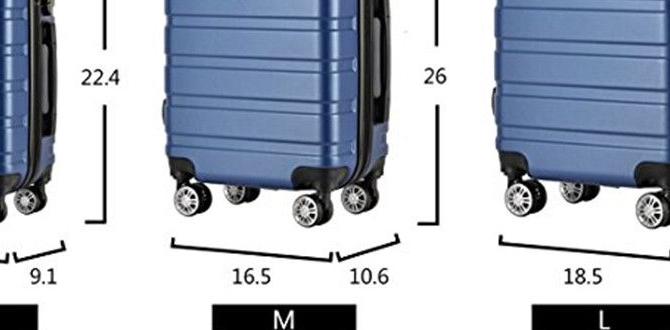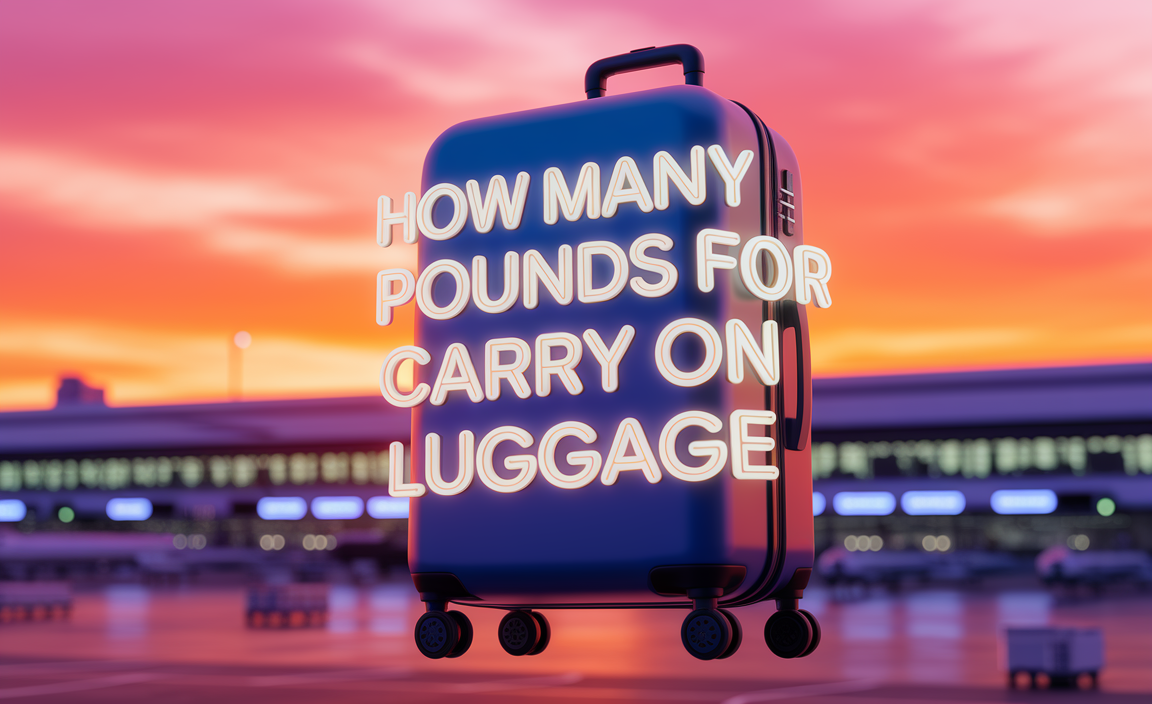Have you ever wondered if your carry-on luggage will fit in the overhead bin? Choosing the right size can be a challenge. Many people face this concern when packing for a trip. Picture this: You’re at the airport, excited for your vacation, and suddenly you hear someone say, “That’s too big!” It’s a common scene, isn’t it?
Did you know the average size for carry-on luggage is no larger than 22 x 14 x 9 inches? It’s surprising how these dimensions can make or break your travel plans. Airlines want everyone to travel smoothly, and these size rules help. But why are there strict size limits anyway?
Imagine playing Tetris with bags on a plane. It’s all about space and balance. Kids puzzle over fitting blocks, right? Airlines have similar puzzles with passenger bags. So, what happens if your bag is too big? You might have to check it in, costing extra time and money.
Understanding these rules can save you the hassle. Next time you travel, picture your bag fitting perfectly. With this guide, you’ll never have to second-guess your luggage size again!
Understanding The Average Size For Carry On Luggage

Understanding the Average Size for Carry On Luggage
Ever wondered what fits in the overhead bin? When you’re packing for a trip, knowing the average size for carry on luggage can save you a lot of hassle. Most airlines allow bags up to 22 inches tall, 14 inches wide, and 9 inches deep. Picture fitting everything you need in a small backpack. Would you manage? It’s like playing Tetris with your clothes! Some travelers find it thrilling to create a perfectly packed bag. What’s in your carry on?
What is the Standard Carry-On Luggage Size?
Dimensions limits set by airlines. Differences in size standards among regions.
Airlines have rules on how big your carry-on luggage can be. In the U.S., many airlines allow a size of up to 22 x 14 x 9 inches. In Europe, some airlines might let you bring bags that are slightly smaller, like 21.5 x 15.5 x 9 inches. Always check with your airline before you fly. Different places have different rules, so don’t forget to double-check!
What if my bag is too big for carry-on?
If your bag is too big, you will often need to check it. You might have to pay a fee. Airline staff may also tag your bag at the gate. This means they will put it under the plane for you. Plan ahead to avoid surprises!
Can you bring a backpack as a carry-on?
Yes, a backpack can be a carry-on. But make sure it fits the airline’s allowed size. Backpacks are handy because they offer easy access and are comfortable to carry.
- Check dimensions before packing.
- Keep essentials handy.
- Use all pockets and zip-ups for organization.
Traveling with a carry-on can save time and money. Knowing the size limits helps plan better. Check your airline’s rules and pack light. This way, you won’t have to worry at the airport.
Airline-Specific Size Requirements
Major airlines and their respective carryon size policies. Comparison of size restrictions across popular airlines.
Airlines have different rules for bags you can carry on. These are important so your bag fits on the plane. What size is allowed for carry-on bags by major airlines? It often varies but there are standard sizes. Let’s look at some major airlines:
- American Airlines: Max size is 22 x 14 x 9 inches.
- Delta Airlines: Same max size, 22 x 14 x 9 inches.
- United Airlines: Allows up to 22 x 14 x 9 inches.
- Southwest Airlines: Slightly bigger, 24 x 16 x 10 inches.
How do these sizes compare? American, Delta, and United have the same limit. Southwest allows a bit larger bags. Knowing these rules helps plan your trip easier. Don’t let your bag be too big—or you might have issues!
Importance of Size Compliance
Consequences of exceeding size limits. Benefits of adhering to carryon size guidelines.
Picture this: you’re all packed up for your journey, ready to head out the door, and… your bag doesn’t fit in the overhead bin. Oops! That’s when the size rule becomes vital. Going over size limits might mean paying extra fees or waiting for your bag at the baggage claim. Yikes! But staying within limits? Oh, it’s sweet! Easier boarding, less hassle, and more time for snacks!
| Consequences | Benefits |
|---|---|
| Extra fees | Smooth travel |
| Bag delay | Easy boarding |
Adhering to size guidelines brings a smile to your face. Airline rules are not there for fun but to ensure everyone’s comfort. “Size matters,” they say, and in travel, they’re spot on! Following these simple guidelines makes travel more enjoyable for everyone on board. So, next time you pack, consider the size and fly through it all with ease!
Factors Influencing Carry-On Size Preferences
Travel duration and destination considerations. Packing habits and personal needs.
What factors affect how big a carry-on bag should be?
The size of a carry-on bag depends on several things.
First, how long will you travel? If it’s just a weekend trip, a smaller bag might work. Short trips need less clothing and items. A long journey may require more space. Next, where are you going? Cold places need warmer clothes. These clothes take up more space. Warm places need less. People have different packing habits too. Someone who packs light needs less space. Others who bring shoes, gadgets, and books need a bigger bag.
Key Considerations
- **Travel Duration**: Short trips need less; longer trips require more space.
- **Destination Needs**: Cold climates need bulky gear.
- **Personal Packing Habits**: Light packers need smaller bags; others might need more.
Tips for Choosing the Right Carry-On Size
Assessing personal travel requirements. Optimizing space within carryon limits.
Finding the right size for your carry-on sounds like discovering a magical world where sock monsters don’t exist. First, figure out what you really need for your trip. Do you need four pairs of shoes? Maybe not! Packing smart is key.
Also, keeping space for souvenirs (or a fancy new sock) is always a plus. If your pack looks like it’s going to burst, rethink your essentials. And remember, like all great puzzles, every piece should fit snugly within the limits!
| Carry-on Tips | Details |
|---|---|
| Personal Needs | List essentials before packing |
| Space Optimization | Roll clothes, use pouches |
These strategies ensure every inch counts. As travel expert Rick Steves says, travel lightly and experience deeply!
The Future of Carry-On Luggage Sizes
Trends in airline luggage policies. Innovations in carryon luggage design.
In a world where airline policies could change faster than you can pack a toothbrush, the future of carry-on sizes is fascinating. Airlines are constantly updating their rules to fit more bags in the overhead bin and ensure smoother boarding. Meanwhile, luggage creators are getting inventive. Picture luggage that doubles as a scooter or one that transforms into a backpack! The future is bright and full of wheels.
| Trend | Feature |
|---|---|
| Airline Policies | Strict Size Limits |
| Innovative Designs | Luggage with Tech Gadgets |
“Adapt or pack lightly,” might be the new traveler motto. As policies evolve, new luggage designs will need to be smarter, possibly even more eco-friendly. Let’s not forget, as long as your bag can hold clothes and your favorite snacks, you’re all set for takeoff!
Conclusion
Most carry-on luggage measures 22 x 14 x 9 inches. This size helps avoid airline fees and fits overhead. Remember these dimensions when packing for trips. Check each airline’s rules, as they may vary. Choosing the right size makes traveling easier and more fun. To learn more, explore airline websites for exact guidelines and helpful tips.
FAQs
What Are The Standard Dimensions For Carry-On Luggage According To Different Airlines?
Different airlines have different rules for carry-on luggage sizes. Usually, your bag should be about 22 inches tall, 14 inches wide, and 9 inches deep. These sizes help your bag fit in the overhead bin. Always check the airline’s rules before packing your bag. That way, you know it will fit!
How Does The Average Size Of A Carry-On Bag Compare Across Various International Carriers?
Different airlines have different rules for carry-on bags. Some let you bring bigger bags, and some only allow smaller ones. Most carry-on bags are about the size of a school backpack. It’s important to check your airline’s rules before flying. This way, you know the right size for your bag.
What Weight Restrictions Typically Apply To Carry-On Luggage, And How Do They Vary By Airline?
When you fly on a plane, you can bring a small bag with you. This is called a carry-on bag. Airlines, which are companies that fly planes, have rules about how heavy this bag can be. Usually, it can weigh from 15 to 22 pounds. Different airlines have different rules, so it’s important to check before you fly.
Are There Any Differences In Carry-On Size Requirements For Domestic Versus International Flights?
Yes, there can be differences in carry-on size rules. Some airlines have different rules for domestic flights and international flights. Usually, international flights might have stricter size and weight limits. Always check your airline’s rules before packing. This way, you won’t have any surprises at the airport!
What Factors Should Travelers Consider When Selecting The Ideal Carry-On Size For Their Needs?
When picking a carry-on bag, check if it fits in the airline’s overhead bins. Make sure it’s big enough to hold your clothes and things. Think about how heavy it is; you will carry it around the airport. Look for bags with wheels to make moving easier. Make sure it fits in important things, like a snack or a favorite book, too.







